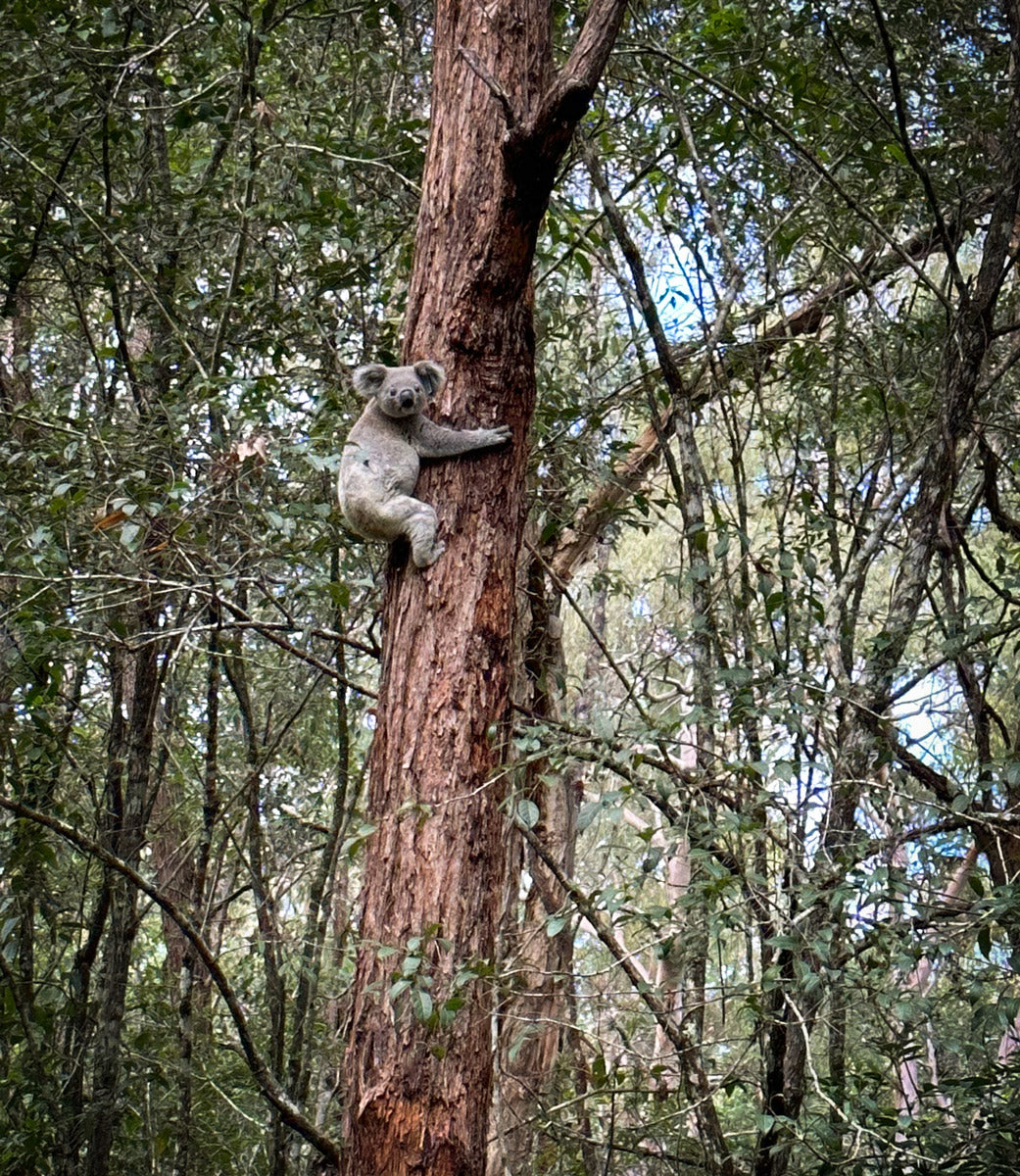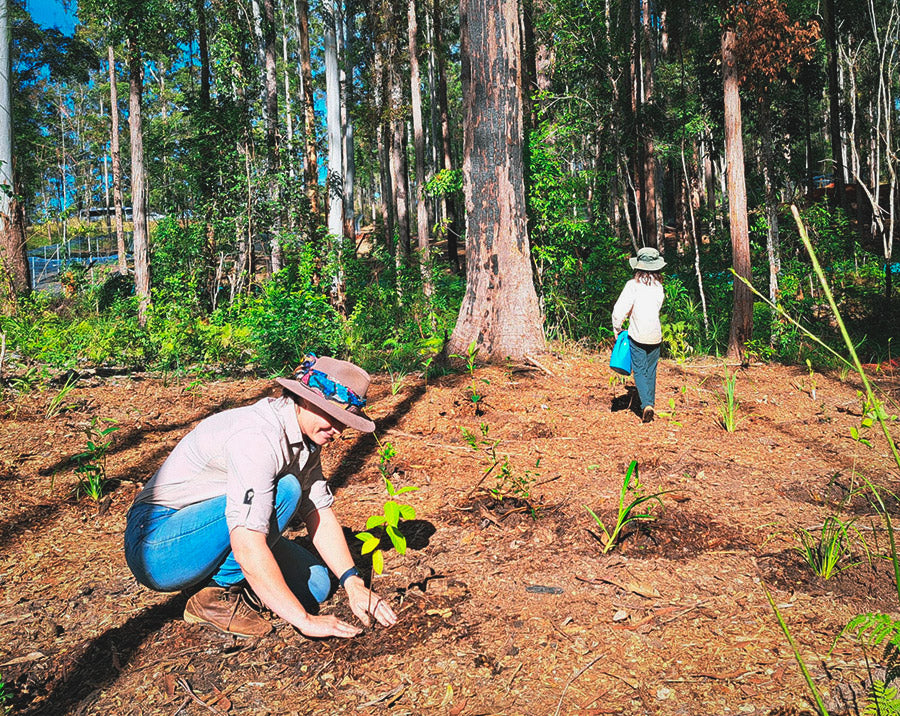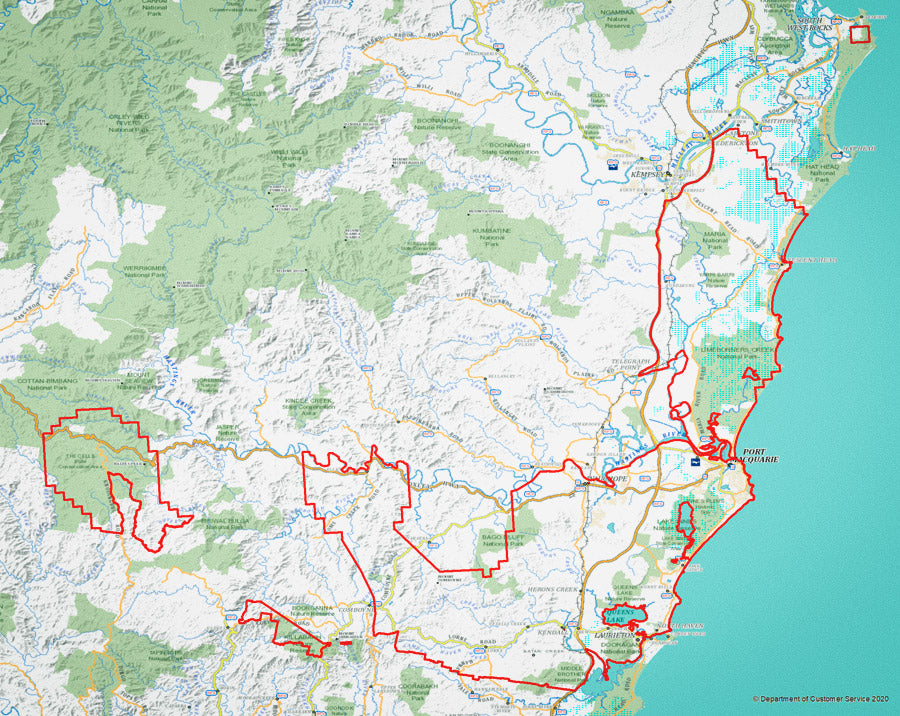Koala Habitat

The best thing we can do for koalas is provide them with large areas of consolidated, high-quality habitat, preferably well away from everyday threats such as roads and urban/ backyard dog attacks.
What does sustainable koala habitat require?
Koalas can live sustainably in areas where:
- Annual rainfall is above 500 millimetres per year
- Maximum daily temperatures do not exceed 40°C for more than a few days, longer than this causes heat stress and mortality
- Altitude is less than 1200 metres above sea level (Australian Koala Foundation 2019).
- Eucalypt-dominated woodland and forests exist. These include: coastal forests, woodlands of the tablelands, woodlands of the western slopes, and riparian vegetation of the western plains.
- Koala food trees are present: Koalas feed primarily, but not exclusively, on eucalyptus leaves. They are known to use 137 tree species, of which 103 are Eucalyptus. However, their diet is quite specialised. At a single site, an individual koala will get most of its nutrition from one or a few species.
- Koala corridors exist: Increasing connectivity between existing koala habitat is essential to allow for koalas to travel safely between sites. This can be done with corridors of vegetation preferably at least 20 metres wide, with appropriate openness to allow koala passage. Any increase in connectivity is valuable. Narrow tree lines also have a place in habitat restoration. Tree lines can connect larger patches. When planted along waterways they provide valuable koala habitat.
Koalas also use isolated paddock trees; trees planted as windbreaks, along fence lines and in utility corridors; as well as some non-native vegetation for shade and shelter.
*Source: NSW Department of Planning and Environment 2022, Koala habitat restoration guidelines.

Ways you can help protect and restore koala habitat - planting koala food trees
The first principle in habitat restoration is to protect existing habitat, even if it is individual mature trees. Improved management of existing habitat, particularly if it shows signs of degradation, can lead to rapid recovery of highly suitable koala habitat.
However, planting and direct seeding are often needed to create new habitats because existing koala habitats have been extensively cleared and fragmented.
A number of considerations when undertaking koala food tree planting
- Optimal tree-spacing and selecting the right tree species - For detailed information on koala habitat restoration relevant to the Mid-North Coast, see here.
- Avoid planting koala food trees near main roads when restoring habitat. Instead, locate stepping-stone plantings to direct animals away from roads and known ‘high strike’ areas.
- Fences can also create barriers to koala movement. Where there is a choice, avoid planting feed trees around fences or ensure fences are of plain wire.
- Avoid planting koala feed trees near locations where koalas would be at higher risk of domestic dog attack. Where such risks coincide with existing koala habitat, dogs should be kept on leads where possible and be restrained at night.

About Hastings-Macleay koala habitats
The Hastings-Macleay region is a beautiful area located on the Mid North Coast of NSW, with a diverse range of environments supporting a high biological diversity. Research by the Australian Museum has revealed four genetically different koala populations within this region. Genetic diversity is important to koalas as different populations show different levels of resistance to existing and emerging diseases.
Map Reference: Map of the Hastings-Macleay Area of Regional Koala Significance (ARKS)
Saving our Species Program
A large proportion of koala habitat in the Hastings-Macleay region has been mapped as “Areas of Regional Koala Significance” (ARKS) as part of work under the NSW Government’s Saving our Species Program.The three ARKS in Hastings-Macleay (the Port Macquarie, Crescent Head and Comboyne ARKS) stretch from the small fishing hamlet of Dunbogan in the south to the surfing beaches of Crescent Head in the north, where the rich soils of the coastal floodplain support good populations of koalas. In addition, there is a known high-density koala population near the town of Ellenborough on the Hastings River floodplain. The area around the Lake Innes Peninsula has also been recognised by the Federal Government as a “Nationally Significant Source Population”. While these mapped ARKS are the core focus of the Koala Recovery Partnership, work outside the mapped areas occurs within the two LGAs.
These coastal floodplains (which are usually the best koala habitat) are also the areas most prized for urban development. The resultant combination of loss and fragmentation of habitat, and associated threats such as dog attack, vehicle strike and stress-induced disease are now taking their toll on koalas. As a result, this once healthy and robust population is in decline. Urgent action is now required to save the species.
Koala Threats
In order of impact, the koalas in our region face these constant (and in some cases growing) threats:
-
Loss of Habitat
Learn MoreDeforestation, urbanisation, bush fires and encroachment have diminished natural habitats for koalas to grow, thrive and reproduce.
-
Disease
Learn MoreKoalas in the wild face the threat of diseases (like chlamydiosis) that, without diagnosis and proper treatment, will quite often lead to death.
-
Injury and Attack
Learn MoreAs a result of diminishing habitats, koalas face the frequent threat of injury or death from motor vehicles as well as dog attacks.
Here's how you can help!
Here are three of the biggest, most significant ways you can help us today!
-
Adopt
ADOPTAdoption is a meaningful and symbolic way to contribute to the conservation of koalas. Adoption allows you to directly fund koala rescue, management of sick and injured koalas and the rehabilitation of koalas and their habitat. Learn about the koalas available for adoption to find who you connect with here!
-
Donate
DONATEMaking a donation contributes directly to the funding of conservation efforts of wild koalas and their habitats, providing care to sick and injured koalas and supporting research and education efforts. Donating is an easy and effective way to directly help our Koala population, a little goes a long way.
-
Visit
VISITCome see us in action to find out what we’re all about! Drop into the Koala Hospital during our opening hours (8:30am to 4pm every day) to get a first-hand look at our facility, including our Koalaseum, care clinic, and shop. You can learn about our rescue and rehabilitation efforts and check out our facility visit our exhibit koalas.
-
Become a Volunteer
VOLUNTEERWe are always on the search for new, passionate volunteers ready to help make a substantial difference in koala safety. Find out more on how you can help our koalas today.
-
Plant a Tree
LET'S PLANT!The major threat to koalas are loss of habitat. A $20 donation will enable us to plant one food tree. Your donation will help nourish koalas in the future, and reduce Australia’s carbon footprint!
-
Report a Sighting
REPORT SIGHTINGIf you catch sight of a koala, complete our reporting form and include any observations to help us monitor koalas. If you observe an injury or signs of illness, call our rescue hotline.